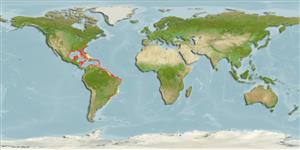Common names from other countries
Classification / Names / Names
Nomi Comuni | Sinonimi | Catalog of Fishes (gen., sp.) | ITIS | CoL | WoRMS
Environment: milieu / climate zone / depth range / distribution range
Ecologia
; distribuzione batimetrica 0 - 101 m (Ref. 83435). Tropical
Western Atlantic.
Length at first maturity / Size / Peso / Age
Maturity: Lm ? range ? - ? cm Max length : 3.5 cm DL maschio/sesso non determinato; (Ref. 83435)
Maximum depth from Ref. 104365. In Belize, it was found in a submarine cave near Columbus Cay (Ref. 87209). Epibiotic, sessile, on hard substrate (Ref. 104365).
Life cycle and mating behavior
Maturità | Riproduzione | Deposizione | Uova | Fecundity | Larve
Members of the class Bivalvia are mostly gonochoric, some are protandric hermaphrodites. Life cycle: Embryos develop into free-swimming trocophore larvae, succeeded by the bivalve veliger, resembling a miniature clam.
Gischler, E. and R.N. Ginsburg. 1996. (Ref. 86352)
IUCN Red List Status (Ref. 130435)
CITES status (Ref. 108899)
Not Evaluated
Not Evaluated
Human uses
| FishSource |
Strumenti
Informazioni ulteriori
Age/Size
Accrescimento
Length-weight
Length-length
Morfologia
Larve
Abbondanza
Fonti Internet
Estimates based on models
Preferred temperature
(Ref.
115969): 21.8 - 27.9, mean 24.8 (based on 424 cells).
Price category
Unknown.
